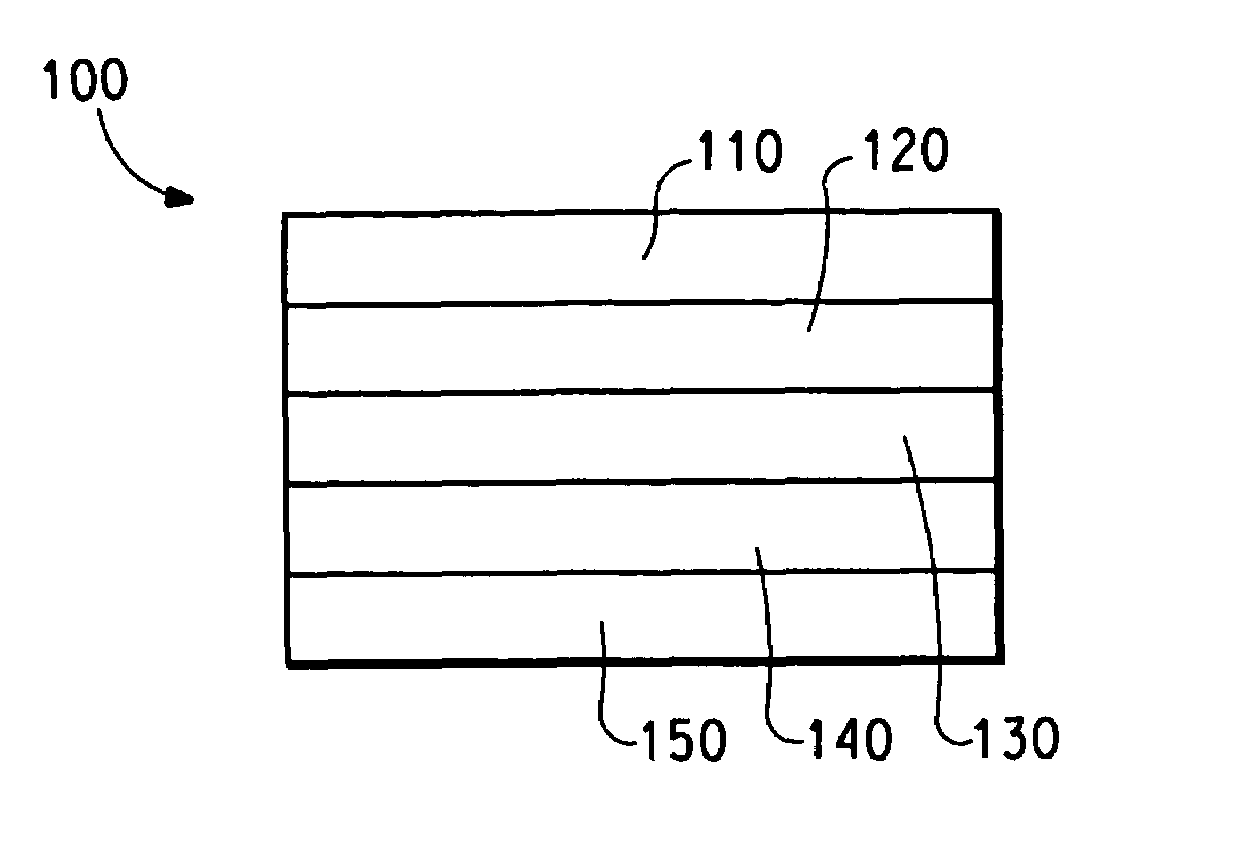Water dispersible polypyrroles made with polymeric acid colloids for electronics applications
a technology of polymeric acid colloids and polypyrroles, which is applied in the direction of non-metal conductors, instruments, conductors, etc., can solve the problems of reducing the stress life of an el device containing such materials, and affecting the electrical conductivity of the el devi
- Summary
- Abstract
- Description
- Claims
- Application Information
AI Technical Summary
Benefits of technology
Problems solved by technology
Method used
Image
Examples
example 1
[0122]This example illustrates the preparation of an aqueous polypyrrole dispersion, in which the dispersed polypyrrole is made with pyrrole and Nafion®, a colloidal perfluoroethylenesulfonic acid (“PPy / Nafion®”).
[0123]A 25% (w / w) aqueous colloidal dispersion of perfluoroethylenesulfonic acid with an EW of 1050 was made using a procedure similar to the procedure in U.S. Pat. No. 6,150,426, Example 1, Part 2, except that the temperature was approximately 270° C. The dispersion was diluted with water to form a 12% (w / w) dispersion for the polymerization.
[0124]To a 500 mL reaction kettle fitted with an electrically controlled propeller type-stirring paddle were added 64.6 g (7.38 mmoles of Nafion® monomer units) of the Nafion® polymer dispersion, 125 g de-ionized water, 62 mg ferric sulfate (Aldrich, Cat. # 307718), and 0.175 mL (2.10 mmoles) 37% (w / w) aqueous hydrochloric acid (Ashland Chemicals, Columbus, Ohio; cat. # 3471440) and the reaction mixture stirred at 200 RPM. After 5 minu...
example 2
[0125]This example illustrates application of aqueous PPy / Nafion® dispersion for polymeric light emitting diodes.
[0126]The aqueous PPy / Nafion® dispersion prepared in Example 1 was used for making light emitting diodes on indium / tin oxide (ITO) / glass substrates. The glass / ITO substrates (30 mm×30 mm) having ITO thickness of 100 to 150 nm and 15 mm×20 mm ITO area for light emission, were cleaned and subsequently treated with UV ozone. The aqueous PPY / Nafion® dispersion was spin-coated onto the ITO / glass substrates for a thickness of 62 nm. The spin-coated films were then baked at 90° C. in vacuum for 30 minutes. For the light-emitting layer, a 1% (w / v) toluene solution of Lumination Green from Dow Chemicals (Midland, Mich.) was spin-coated on top of PPy / Nafion® films and subsequently baked at 130° C. in nitrogen for 30 minutes. Immediately after, 3.0 nm thick barium and 550 nm aluminum were deposited on Lumination Green films to serve as a cathode. The diodes exhibit 1,000 cd / m2 lumin...
example 3
[0127]This example illustrates some of the properties of dried solids prepared from aqueous polypyrrole / Nafion® dispersion.
[0128]0.418 g of the dried PPy / Nafion® prepared in Example 1 was mixed with 9.6 g of de-ionized water. The water remained clear even after standing for a long time. The result clearly indicated that dry PPy / Nafion® films did not re-disperse in water. The water in contact with the dried PPY / Nafion® had a pH of 6.3, indicating that acid was not leaching out. Moreover, moisture uptake was less than 1% after 24 hours at ambient conditions. These characteristics are important in materials aimed for OLEDs, anti-static coatings, electromagnetic shielding, and microelectronics applications, such as field effect transistors, electrochromic displays, and memory storage.
PUM
| Property | Measurement | Unit |
|---|---|---|
| wt % | aaaaa | aaaaa |
| particle size | aaaaa | aaaaa |
| particle size | aaaaa | aaaaa |
Abstract
Description
Claims
Application Information
 Login to View More
Login to View More - R&D
- Intellectual Property
- Life Sciences
- Materials
- Tech Scout
- Unparalleled Data Quality
- Higher Quality Content
- 60% Fewer Hallucinations
Browse by: Latest US Patents, China's latest patents, Technical Efficacy Thesaurus, Application Domain, Technology Topic, Popular Technical Reports.
© 2025 PatSnap. All rights reserved.Legal|Privacy policy|Modern Slavery Act Transparency Statement|Sitemap|About US| Contact US: help@patsnap.com



